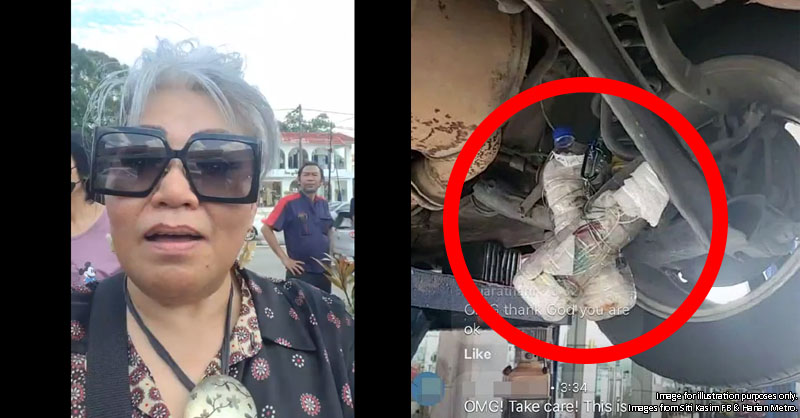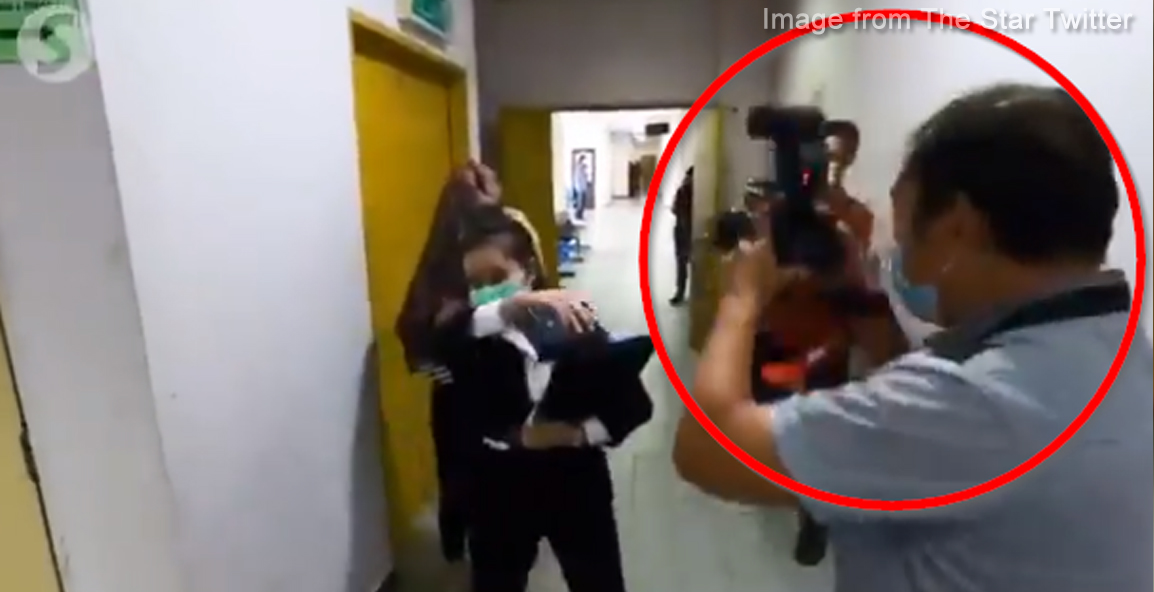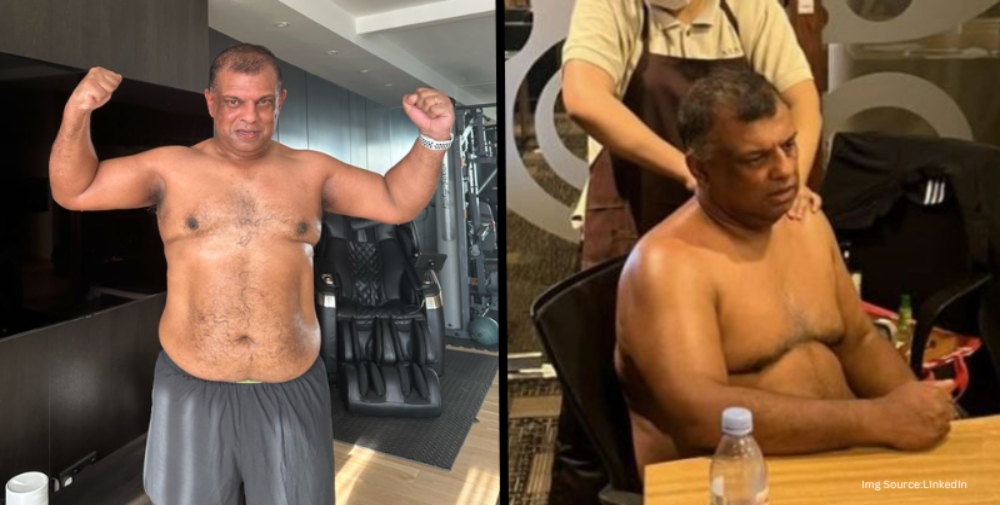6 ways to spot a cybertrooper in Malaysia

- 1.3KShares
- Facebook1.2K
- Twitter5
- LinkedIn20
- Email14
- WhatsApp51
With GE14 coming up, everyone has become busy bees. The politicians are ceramah-ing, the EC officers are officing, the PACA volunteers are PACA-ing, the flag cucukers are cucuking. But there is another group of people who are probably gonna be working overtime too…the cybertroopers.
What is a cybertrooper? Being a Malaysian who uses social media, some of you would be familiar with this community. They are the macais, the keyboard warriors, catfish. Their job is to trawl online news sites and social media postings for any bit of information that could be used to counter party criticisms, or to attack the other political parties in return. They might be working for both sides of the divide. In fact, the word “cybertrooper” itself could have originated from Malaysia! ?
We spoke to a reformed cybertrooper Ahmad Marzuki (not his real name, lel) and he spilled the kacangs for us which gave us insight into strange life of being one of the most annoying people you can find in forums and comment sections. Buttt sometimes there can be thousands of people commenting on a post… howdja tell real persons from fake accounts? Here are 6 ways to spot a cybertrooper.
1. There’s weird or NO basic information about them

You know when you click on somebody’s Facebook account there’s this brief biography about the user on the left of the page? If the info seems catfishy, it could be a sign that the account is fake. For example, if the individual claims to have been born in Taiping, Perak, but went to school in Moscow, Russia, and now works for a tech company in Mumbai, India…bau ikan.
But you never know la, mebbe he/she is a bit of a nomad, so it wouldn’t hurt to check. If the person really has been stationed in all these places, they would surely have photographic evidence of their life, provided they’ve made their photo album public also, heh.
An empty bio is also a sign that the account could be fake. If it’s left blank, the fler is either super lazy, or a cybertrooper. You decide. In any case, you could Google a person’s name and info about them (company, alumni, hobbies, clubs and societies) to see if it checks out.
2. They have weird un-Malaysian names

Often times, cybertroopers have strange un-Malaysian fake names for their account, like Suzuki Honda, or Lionel Messi. We even came across one possible one called Fraggie Looss. However this is not always the case, because as they get more sophisticated, they’d know to use regular Malay, Chinese or Indian names coz looks more legit laa.
Yet, we cannot ignore the fact that some users do use nicknames. Sometimes they spell their name backwards, or they’ll add in a nickname that only their close circle of friends know, or maybe they use celeb name they love, etc. Even when you scroll among your friends, you might come across names that you don’t recognise and wonder if that’s some old school friend or someone you met at a party once. hmm 😕
3. They have very few personal pictures
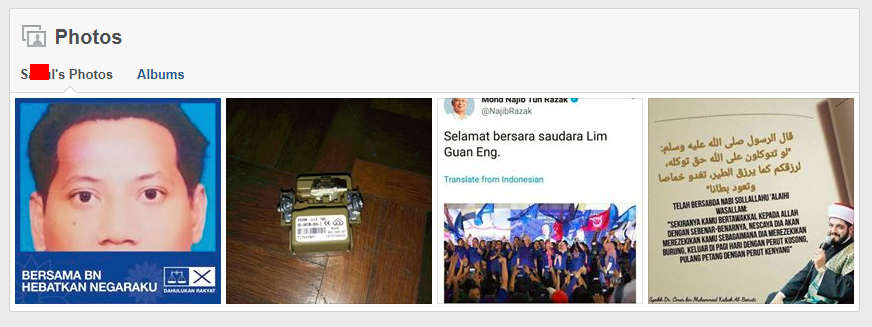
Any normal Twitter, FB or Instagram user would upload their own photos from time to time, ie. family reunions, food (duhh), travel pics, outings with friends, their newborn baby, pets, and so on.
Cybertroopers on the other hand ain’t got time fo dat. If you were to scroll through their account, they rarely post a lot of photos and you probably wouldn’t find any photo albums either. It might all just be lunked in their timelines. Instead, what you might see are random photos of footballers or football club logos…or cats. But it could be that they’re really really really REALLY big fans of football. Or cats. BUT bear in mind that perhaps they have high privacy settings la.
One other way to check if an account is fake is through their profile photo. It’s often the case that fake accounts use a photo that they’ve downloaded from somewhere else online, namely other unsuspecting Malaysian’s (or Asian people’s) photos. Some people have been shocked to find their dead friends or relatives defending our PM from beyond the grave. Even some who’re still alive also kena:
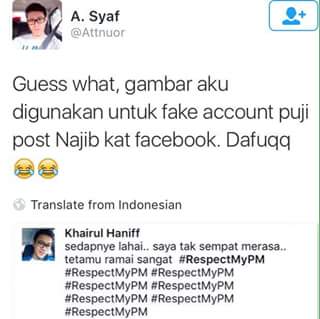
So how can you tell if a person’s photo is really theirs (besides seeing the same guy or girl’s face in all their postings)? Just fire up Google Image Search, drag the profile photo and drop it into the search bar and see what results you get. If the photo is from a fake account, you should see loads of matches all across cyberspace, belonging to other people. Tooot.
4. Their walls are littered with political posts. And nothing else

If the person’s account is all about BNBNBN or PakatanPakatanPakatan then he/she seriously needs to get a life, or is a cybertrooper. True, the person could be really really really REALLY passionate about the Malaysian political scene, but c’mon, normal human beings would at least post some food or personal photos.
Content wise, if the account excessively duplicates its posts/tweets or talks like a robot (most notably, if the tweets are all @replies with the same text), then it could actually be a bot.
Additionally, fake accounts tend to have an unrealistic number of posts or tweets. Like seriously, who has time to tweet ten thousand times a day?! In our search, we came across accounts like that. One Twitter account (pic above) was created in April 2018, so that’s like 30 days old, right? It has 890 tweets. Average it out, that’s like almost 30 tweets a day? Ok, if you wanna say the person is chatty we geddit, but for this particular account, all the posts are about politics – mostly pro-BN and use the hashtags #JomBN, #BersamaBN and #KitaPilihBiru.
5. They don’t tag their friends or fam

Regular folk do regular things on social media and you call tell from the recent activity on the user’s wall or feed. Most likely if the user is performing various activities from time to time, such as posting updates, adding photos and especially getting tagged or tagging friends, then they are more likely to be real accounts.
In fact, tagging is probably one of the more obvious ways to tell. A cybertrooper may take the time to upload a bit more photos and post more statuses, but they wouldn’t often (if at all) tag people, particularly in group or family photos, because their ‘friends’ or ‘followers’ are not actually real friends or followers.
On the other hand, other reports say that fake accounts may tag 100 times more than real users. On average, a fake account tags about 136 times for each 4 photos while a real account tags just once among each 4 of them. Which brings us to our next point.
6. They’re all friends with each other

At one time, it was probably reasonable to think that if someone has a group of friends interacting with them and vouching for each other, the person must be real. Not anymore! There are cases of one person running numerous fake accounts, pretending to be an array of different people, insiders explain.
Oftentimes cybertroopers are also friends with each other or follow each other’s accounts. At times, cybertroopers would also have very few friends – we’ve come across some accounts with NO friends, one friend, 47 friends… wut?! Considering that our country ranks 10th globally for number of friends (which is 60% more than the global average of 338), making the Malaysian average 541 friends, it seems dodge for an account to have less than 100 friends.
Granted there is a possibility that the person is very private and doesn’t like having too many social media friends. But more importantly, people can also set high privacy settings so that you cannot see who their friends are.
At the end of the day, they’ll do their best to fake it till they make it

So these are just some of the ways you can spot a cybertrooper on social media, whether it’s created by a bot or being managed a real person employed by an agency, like Ahmad Marzuki was.
Regardless, you’ll notice we put a lot of caveats in each of the 6 points. Just because an account LOOKS like a fake account, doesn’t mean it is one. It could be a really antisocial user. Likewise, just because an account looks legit, it doesn’t mean the person’s not a cybertrooper. It could be a really hardworking cybertrooper. Tags, uploads photos, replies comments, etc. 😀 It’s like, if you’re gonna make a fake LV bag, you’re not gonna make the logo LW. You’re gonna wanna make it look as authentic as possible.
So how can you really tell if the account is fake or real? Well, if you’re really hardworking, there are ways, like going into all the details. You could Google search their name, their place of work, their families, their friends, check their photos (but then it’d be kinda creepy that you’re doing that. >.> ) Chances are real people would have other accounts that match up with the FB, Twitter or Insta, they might even have a LinkedIn account, proving that they work in such and such company.
And then there are tools to weed out the real from the fake. For example, TwitterAudit can automatically scan followers, revealing the number of fake followers, or the Account Analysis tool to look at accounts individually and detect consistent daily rhythms and constant retweeting of spammy handles or accounts.
What’s important is if you suspect a dodgy account, best take their comments or whatever they share with a pinch of salt, coz they probably want to push an agenda (or are paid to push an agenda).
- 1.3KShares
- Facebook1.2K
- Twitter5
- LinkedIn20
- Email14
- WhatsApp51

